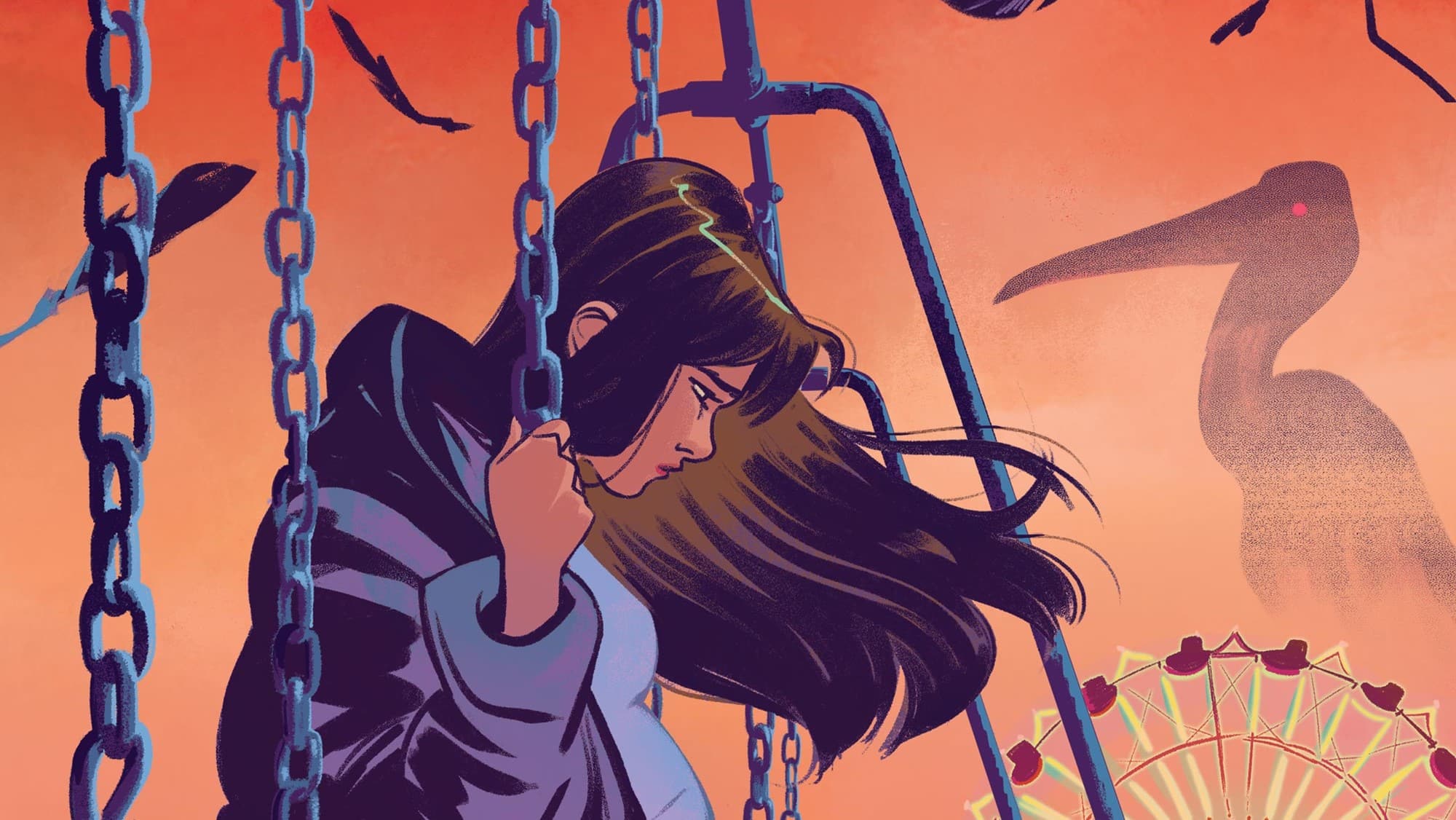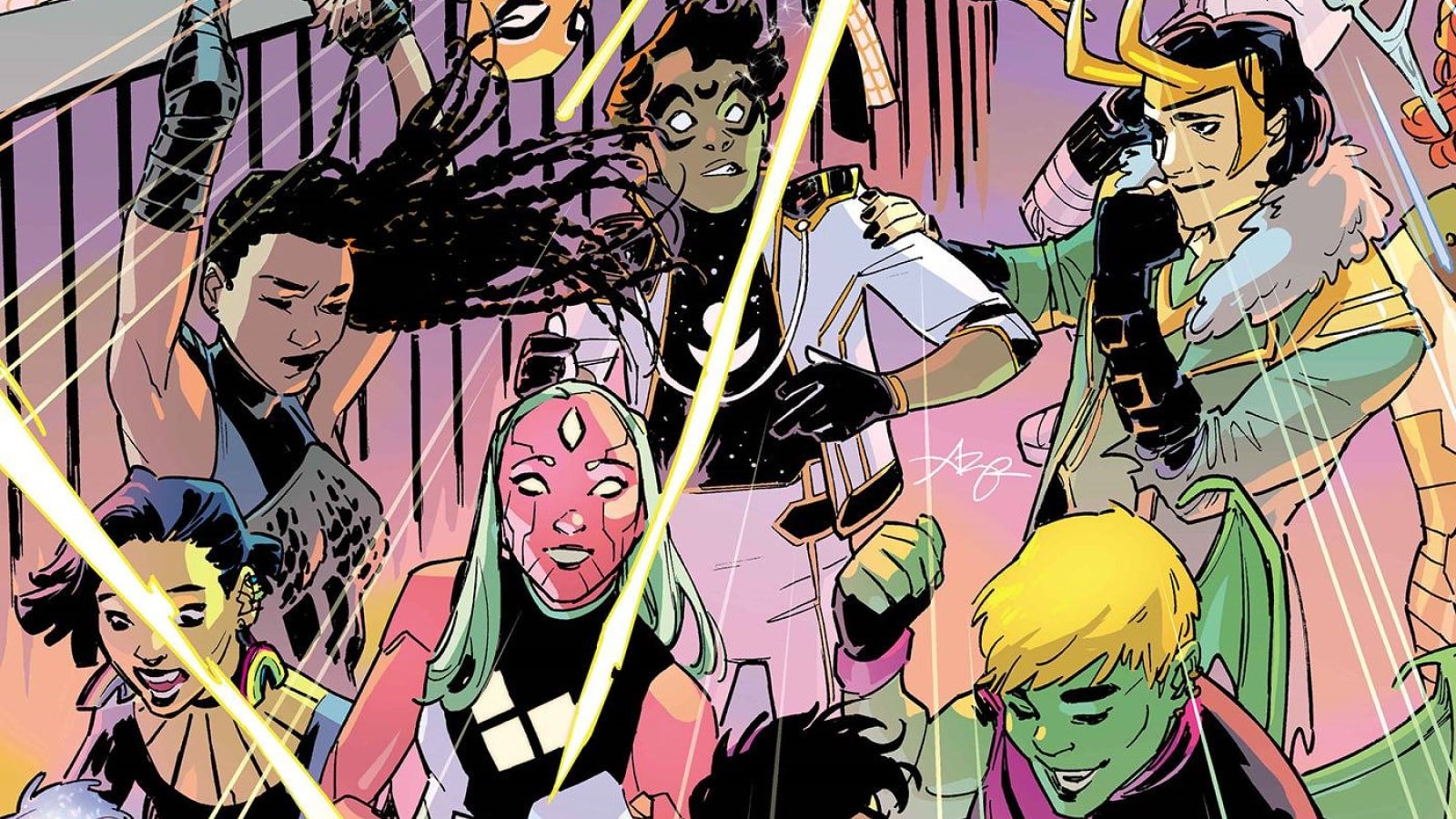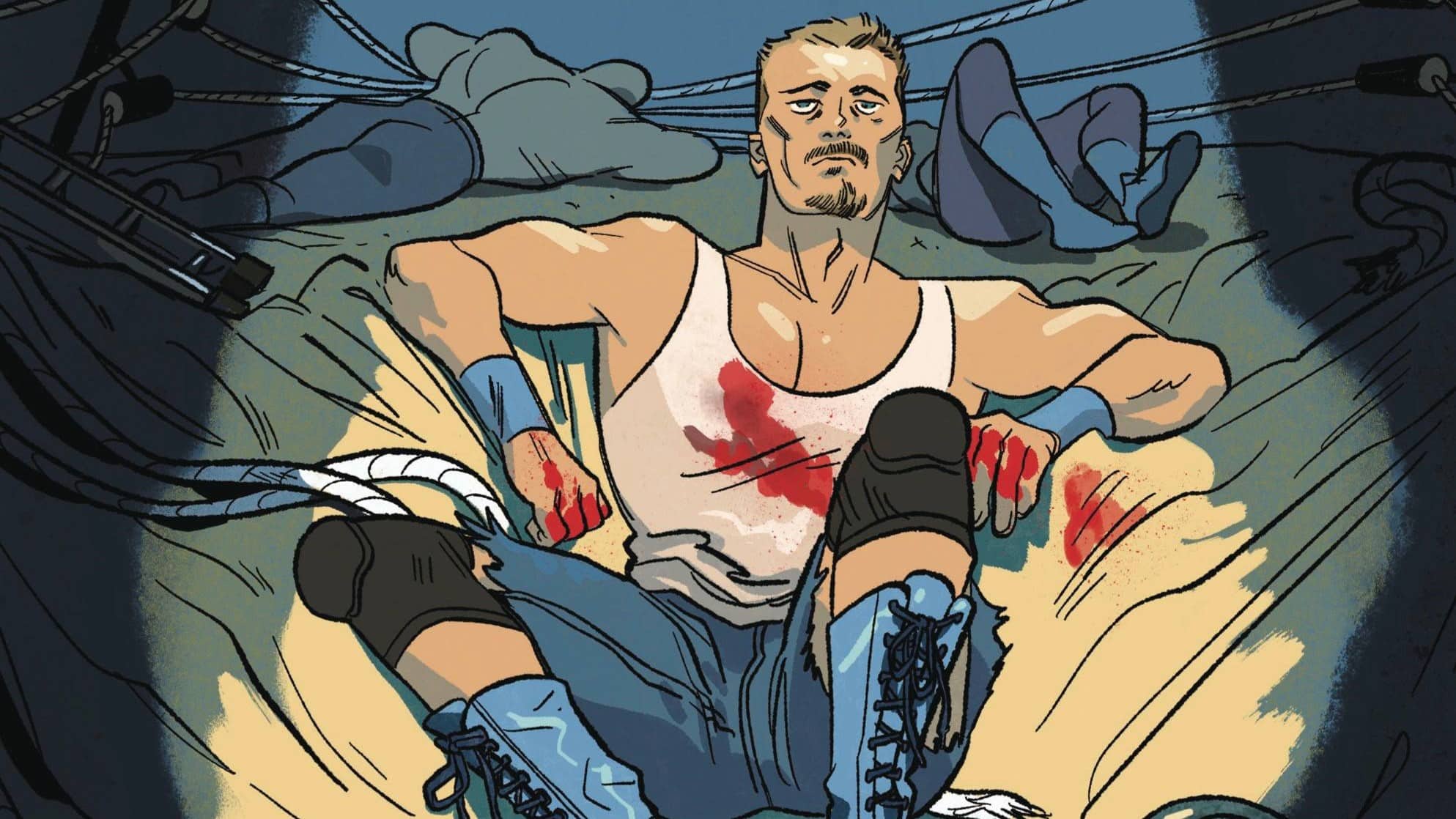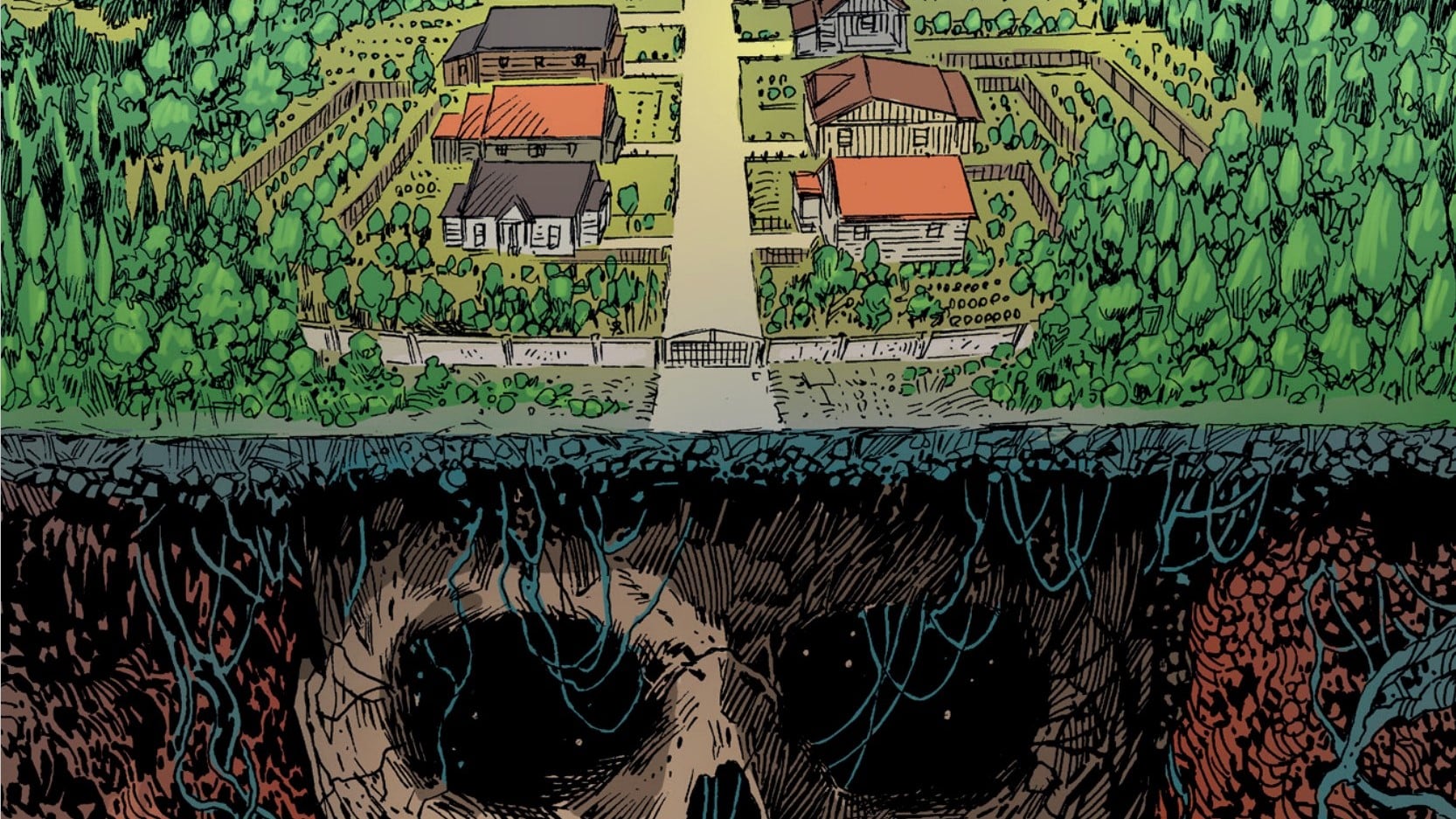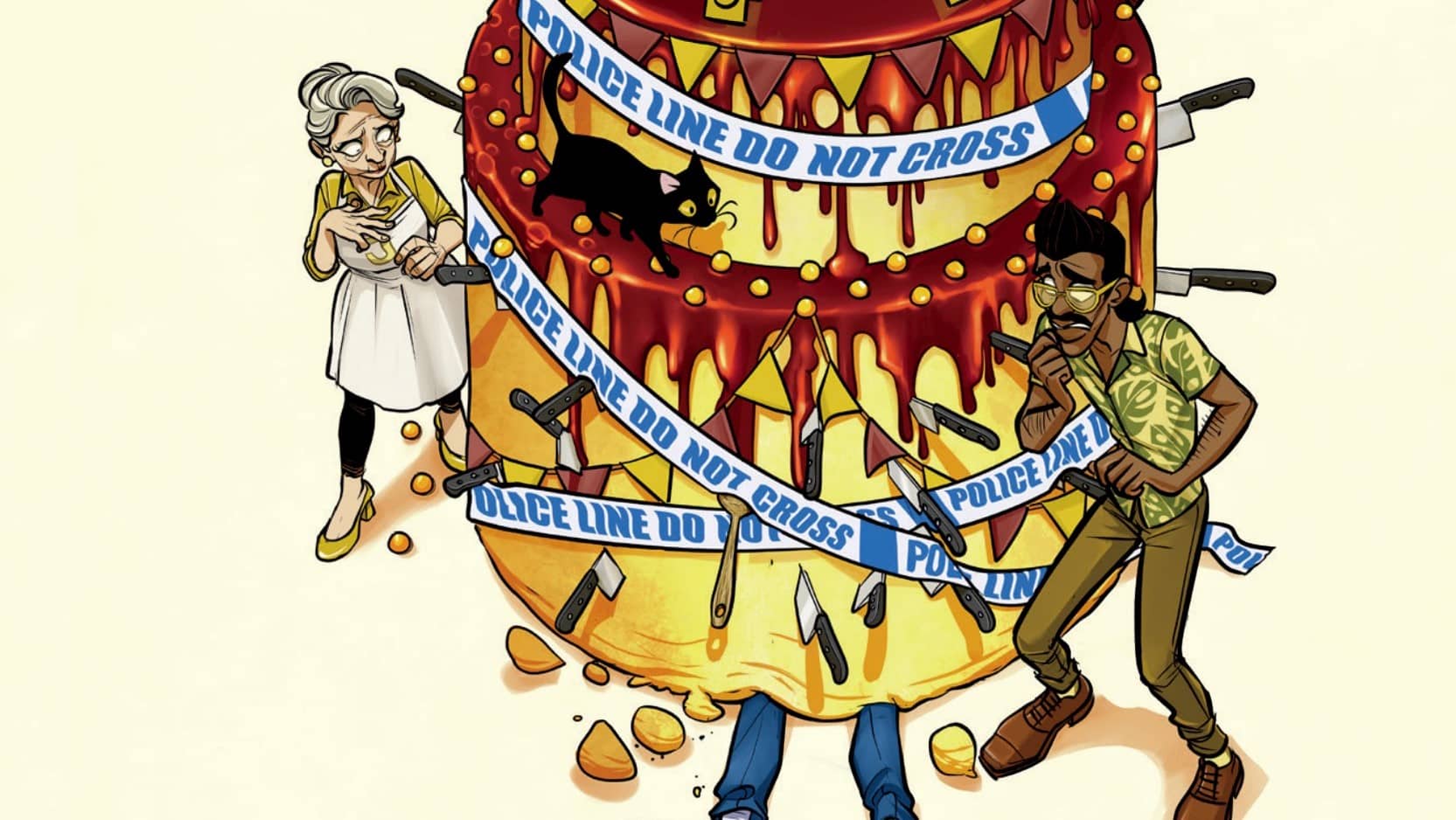In space, no one can hear you scream … when your appendix bursts in ET-ER #2. “Hero” is written by John Lees, drawn by Laci Krstic, colored by Miroslav Mrva and lettered by AndWorld Design. “Precious Cargo” is written by Michael Corst, drawn by Mark Texeira, colored by Dan Brown and lettered by Steve Wands. “Final Cut” is written by Stuart Moore, drawn by Nelson Blake II, colored by Mrva and lettered by Wands. Published by AWA.
All that stands between a pregnant teen and her bodily autonomy is “The Storkening” in Afterschool #2, written by Kate Herron and Briony Redman, drawn by Leila Leiz, colored by Giovanna Niro, lettered by Pat Brosseau and published by Image/Skybound.
Just fucking cancel comics. NewThink #2 is written by Gregg Hurwitz, drawn by Ramon Rosanas, colored by Lee Loughridge, lettered by AndWorld Design and published by AWA.
Will Nevin: Ian, I want the record to show: I’m big enough to admit when I’m wrong and honest enough to admit my mistakes. And, well, partner, giving NewThink another try was one of my biggest lapses in judgment since I wore those super tight shorts to a band contest in ninth grade and split the ass right out of them. How does it feel being so goddamned right?
Ian Gregory: You know, Will, it feels pretty good. I think I’m gonna hold this one over you for a long time.
Will: You earned the privilege, my friend. But for the sake of today’s discussion, I’m going to make you wait for it. Probably out of spite. Once again, it’ll be an anthology sandwich on AWA bread with a Skybound hunk of monster meat. What exactly is wrong with the bottom carb, though, I’m not sure. Stale? Moldy? Is it even there? Let’s investigate … eventually.
Ian: I’d say it’s like the ends of a loaf, except I like the ends. I’m worried, however, that I may have come to a dark realization about myself: Do I even like anthology comics? More on this later.
Will: End pieces? Oh yeah, they’re fuckin’ great.
ET-ER #2: Space? Oh, Yeah, That’s Full of Death

Will: What’s better than one anthology story? How about three? I thought this was a fun, interesting read that continues to be a solid execution of a high-concept idea — who would have thought you could have made a series out of alien medical drama? And this issue works best when it’s more serious. I didn’t have anything against Stuart Moore’s story of a fussy, prickish director who gets his in the end, but to me, it didn’t fit all that well with the other two stories.
Ian: The stories are a little more even this week than in the first issue, but you’re right about the tonal mismatch. That said, I got a real laugh out of “Spitter (Space Twitter),” even if the rest of the story didn’t do much for me. As is often the case with these satire stories, I feel like the jokes are all 10 to 20 years out of date. Do we really need more jokes about drug-addled, narcissistic directors? Do something new.
Will: As someone who just listened to a podcast on John Landis, I think we need more, actually.
Between the other two pieces, I guess the alien transplant team was my favorite. Not so much for the overall story, I think, but because it had such a very human ending. Death, it seems, is undefeated — even in the stars.
Ian: That was the only story this week that had any real tension. I could really feel the pressure of time, and I felt that the end of the story wasn’t totally certain from the outset — that is, that the driver, popping pills to focus, might have conceivably careened into an asteroid. It makes good use of climax-anticlimax, as all the catharsis we feel of the ambulance arriving safely is spoiled by the anticlimax of the nature of death. Overall, this was easily my favorite story of the issue.
Will: The other story — of miners dealing with giant hostile wasps on a barren world — was every bit as good and resonant with absolutely electric art. Maybe I liked that one more. It was really hard to pick between those two.
Ian: This one didn’t do it as much for me. I liked the classic horror movie approach, like we were jumping into the first hour of Perfect Dark or something, but I wasn’t as invested in the fight scene that takes up about a third of this story. Laci Krstic was doing great stuff on the art here, but I felt like this was a little too exposition heavy.
The final turn, with the ominous looming medical robot, however, was pretty good.
Afterschool #2: Reproductive Rights Forever and to Hell with Evil Storks

Will: Let’s start with an important note here. The Supreme Court can get righteously fucked for its decision in Dobbs v. Jackson Women’s Health Organization. Our country is a fundamentally more dangerous, unhealthy, miserable and frightening place with the culmination of a generation of disingenuous political warfare that sought nothing more than to imprison pregnant people in their own bodies. It is a movement built on the exercise of raw power absent any other concern and only marginally distant from bombings and church assassinations.
So this is a timely and important story. I almost called it an allegory, but that’s not quite right, is it? A monstrous stork forcing teens to carry children to term isn’t really a stand-in for anything else.
Ian: What made the last issue of Afterschool work so well was that it wasn’t overly moralizing — not like that ridiculous issue of Grimm Tales of Terror: Back to School. You get the sense that something is being said, but they don’t feel the urge to beat you over the head with “this is a bad person” or “this is a bad thing to do.” Maybe I feel this way because I so strongly agree with this issue’s message, but I do think there’s something to be said for telling a story about something, rather than saying something with a story attached.
Will: My disgust at Dobbs, the “pro-life” movement and basically everything else about our current political moment aside, I thought this idea ran out of juice pretty quickly — after you get into the concept and it becomes just another actioner, there’s not much there there. Although I will admit, the detour into the abandoned amusement park and the cliched Tunnel of Love was pretty solid.
Ian: I think the issue paces itself fairly neatly. The first half of the story deals mainly with the social pressures surrounding unwanted pregnancy, and that works well. We see how people can be affected by thoughtless remarks from their family, expectations and even teenage gossip. I felt the transition to horror-chase sequence was actually right on time, and the variation in set pieces kept it from becoming too stale. That said, a lot of how much I enjoyed this issue hinged on the stork’s qualities as a horror villain.
Will: Finally, how about the nightmare fuel design of the stork, eh? A beak with teeth? Get the fuck out of here with that.
Ian: Extremely good stuff. I love that we can see the stork lurking outside Leah’s window before it reveals itself, and the first half-page spread of it coming down the hallway, mainly in silhouette, is awesome. I love its gross little shark teeth, and the way it tears after our heroes. As far as horror monsters go, this one is really strong.
NewThink #2: This Fuckin’ Sucked Big Time

Will: OK — time for Will to get his medicine. Why were you so convinced (and correct) that this issue was not going to be any good? I was no huge fan of the first, but it was at least fairly banal in that it didn’t have anything to say. This has plenty to say and it’s all bad. Bad and dumb, Ian.
Ian: The first issue displayed such a lack of imagination that I could not imagine the second would be in any way better. Will, imagine you were given 24 pages to tell a self-contained story, about any topic you wish. If you were given that kind of artistic freedom, and chose to make it about how screens are bad, I would roll my eyes but carry on. But if you then decided to do a second issue, and the story you chose to tell was about how writers are Good and Strong and Brave and Necessary, then I would stop being friends with you.
Will: *sad eyes emoji*
I’m not sure if I have the right read on this (because it’s so Boomer-tastic and terrible; I have my doubts that anything could be this dense), so please check my work. We are presented in this issue with a fanciful land of storytellers (social media platforms) with people who go from town to town (users) to share stories good, bad, irrelevant and everything else (content). But what’s this?! An evil king wishes to punish a storyteller (“cancel”) who tells a story he doesn’t like, and her punishment is that her walls are turned to glass so everyone can see into her home. But then the town rallies around her and all is saved!
Ian: OK, I’m glad we both read that as a “canceling” analogy, though I also read it as maybe just plain old censorship (that old bugbear of self-important writers the world over). Canceling probably works better, because the king’s punishment is to make everyone hyper-analyze the storyteller’s life. Hang on a minute, isn’t that just regular social media? Is the king Jack Dorsey? Are the storytellers meant to represent traditional storytelling, and the glass houses social media? I’m getting lost.
Will: I had all of the problems with this. To say something offensive online is not brave — it’s just fucking offensive. And we have always — ALWAYS — faced societal consequences for our speech. Dave Chappelle and J.K. Rowling, to borrow two bigots as examples, decided to make transphobia a brand after people begged them not to and tried to educate them in good faith. Yet they have suffered no injustice, and they will continue to make millions. There is nothing contrary to the freedoms and traditions of this country to say that those two suck really, really hard and that they should fuck all the way off.
But this book treats this simple truth as something terrible and confuses the government’s obligation to protect speech with our responsibility to tolerate it. That’s not how any of this has ever worked.
Ugh. I really hated this.
Ian: Did you get Trumpian vibes from the king? At this point, when I read any hackneyed social commentary I just assume there’s a Trump analogy buried in there somewhere. I also rolled my eyes so hard I almost got retinal detachment at the line “But you can never kill a story.” Basically nothing makes me angrier than writers telling stories about how important and special writers are. Go huff your own farts somewhere I don’t have to read it.
Will: Art? Art do anything for you?
Ian: Yeah, no knocks against Ramon Rosanas, who did some great work on this issue. I felt like the crowd scenes were great, and I loved the clean geometry of the fairy tale. Loughridge was doing a good job with those flat colors, too. I just wish they were attached to a different story … any other story.
Does This Smell OK?
- Sound Effects Watch: Afterschool #2 was chock full of sound effects — I mean, literally, filling the page with the sounds of the stork. I’m giving this week’s award to just the sheer volume in that issue.
- Rapid fire questions:
- If you had an alien virus, what would it do?
- Will: Becoming allergic to oxygen sounds like a terrible way to go, doesn’t it?
- Ian: It’d be like that one episode of The Next Generation where everyone mutates into giant animals.
- Will: You mean the seventh season’s “Genesis,” in which Lt. Barclay devolves into a half-man/half-spider? That scared the shit out of me.
- What do you think the American conservative political movement will fuck up next?
- Will: The motherfuckers are literally becoming antidemocratic. What a fine fucking time to be alive. Thanks, mom and dad.
- Ian: They’re bringing back Prohibition, somehow.
- When we’re all gone, what will poor edgelords do with themselves online?
- Will: Lord willin’, they’ll all eat themselves — metaphorically first, then literally.
- Ian: They’ll stabilize into a self-sustaining ecosystem of video essays criticizing other video essays.
- If you had an alien virus, what would it do?
- Hotel leftover tip: The minifridge in your room might not be the best place for the food you’re trying to cram in there.
- Good on the USDA for using back-to-school fever to emphasize food safety, sure, but no one is “cooking a frozen item for your child’s lunch.”
- CBS11 out of Dallas-Fort Worth has some ideas for school lunches, but I’ll never know what they are because I’m not watching a fucking video.
- Huh?

